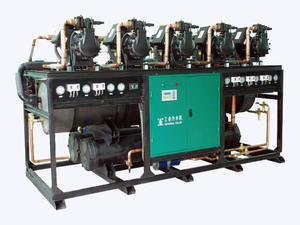Semi-hermetic compressors employ capacity control mechanisms to adjust the compressor's capacity according to the fluctuating cooling or heating load. These mechanisms help regulate the compressor’s performance by either reducing or increasing its output. One of the most common approaches is the cylinder unloading system, where a number of cylinders are deactivated or bypassed, effectively reducing the compressor’s capacity during times of lower demand. This allows the system to operate efficiently without wasting energy. The system typically utilizes mechanical unloaders or electronic unloaders that modulate the suction and discharge valves, ensuring that the compressor operates at an optimal capacity level, thereby reducing energy consumption when demand is low and ramping up when required.
The incorporation of variable speed drives (VSD) into semi-hermetic compressors enables dynamic motor speed adjustment, allowing the compressor to modulate its speed based on the current cooling or heating requirements. This advanced feature optimizes compressor performance by ensuring it operates at its most energy-efficient level, adjusting the speed to match varying load conditions in real-time. For instance, when the demand for refrigeration or air conditioning is low, the compressor motor speed will be reduced, consuming less energy. Conversely, when the load increases, the motor speed is ramped up to meet the demand. By operating the compressor at variable speeds, VSDs reduce the frequency of on/off cycling, lower wear and tear, and improve the system's energy efficiency.
Electronic expansion valves (EEV) are often used in conjunction with semi-hermetic compressors to optimize refrigerant flow in response to load variations. The EEV regulates the amount of refrigerant entering the evaporator coil, adjusting its flow to maintain the desired superheat and ensuring that the system operates within the ideal parameters for efficiency. This dynamic control helps the compressor avoid short cycling and ensures proper heat exchange between the refrigerant and the evaporator coil. The precise control over refrigerant flow provided by EEVs is particularly beneficial in applications where load fluctuations are frequent, such as commercial refrigeration or HVAC systems. By maintaining consistent refrigerant superheat, the EEV also enhances compressor longevity by reducing the risk of liquid refrigerant returning to the compressor, which could otherwise cause mechanical damage.
Semi-hermetic compressors are equipped with load/unload mechanisms that are critical in adapting to changes in system demand. When the load is lower, the compressor can “unload” by reducing the number of active cylinders or bypassing certain components. This helps to avoid energy wastage by running the compressor at full capacity unnecessarily. When the cooling or heating demand rises, the compressor will re-engage its full capacity, ensuring that the system meets the required output. These mechanisms prevent short cycling, which can result in energy inefficiency and wear on the compressor’s components.
Digital controllers and pressure control systems are essential for managing load variations in semi-hermetic compressors. The digital controllers continuously monitor system parameters such as suction pressure, discharge pressure, ambient temperature, and evaporator conditions. By evaluating this data, the controller can automatically adjust the compressor’s operation to maintain optimal pressure and temperature conditions, which ensures that the system is operating efficiently even during fluctuating loads. In addition to pressure adjustments, these controllers help reduce the frequency of compressor starts and stops, thus minimizing energy waste and prolonging the compressor's lifespan.

 English
English عربى
عربى 简体中文
简体中文












